Engagement Ring - In Progress
Setting
Stone
Limited Time: Purchase any Engagement Ring and receive a $250 Gift Card for your Wedding Band.
We guarantee that every single purchase directly impacts one person's life by giving them access to clean water.
Congratulations! You’re getting engaged! It’s such a happy time. However, it can also be a stressful one. How do you choose the right engagement ring? What diamond shape is best? How do you make sure it’s worth what you pay? There are so many questions. Luckily, there are some tips and tricks along the way to make sure you pick the perfect diamond shape for your taste and your finger. Let’s explore.

Round diamonds are exactly what they sound like – diamonds with a circular outline. Since their creation, Round diamonds have been the most popular shape in the world. They are classic and timeless. They are also the most brilliant! In fact, gem cutters and mathematicians have spent decades refining the Round brilliant to make them the most sparkly diamond out there. This is because, out of all the diamond shapes, the facets of a Round Brilliant are the most ideally aligned. In other words, when light enters an ideally proportioned Round Brilliant, it bounces around within the gem, and then almost all of it sparkles back out at you, multiplied!

Luna Engagement Ring with 6.4mm Round Diamond
Anyone who wants MAX sparkle. Round diamond shapes are great for, literally, everyone. Because of their maximum sparkle, almost all couples will love Round cut diamonds. Also, because the shape is so popular, almost all settings will accept a Round diamond shape. So, even if a couple wants a more angular or artistic setting, a Round diamond will still likely work and be beautiful.
Because Round diamonds are so popular, they may not be the best choice for couples looking for something truly “unique.” So, if your main goal in your engagement ring is to be different – a Round diamond shape is probably not what you want. Luckily there are at least 9 other diamond shapes out there!
Couples choosing a Round diamond shape should look for an Excellent cut, “eye clean” clarity (usually SI1+), and “white” color (usually H+). In addition, be sure to look at the measurements of your stone to make sure they are maximized within carat weight. In other words, you want the biggest looking stone for your buck! Check out our Round diamond buying guide for more info on how to select the best Round.
Couples that love Rounds should also check out Ovals and Cushions before settling on their diamond shape. Both Oval and Cushion diamond shapes have soft curves with great sparkle, just like Rounds. However, Cushions and Ovals are often less expensive than Rounds of similar quality. And Ovals often look larger.

Round vs Oval vs Cushion Diamond Shapes
Princess cut diamonds are square stones with straight edges and 90-degree corners. So, they are very modern diamond shapes. They are “brilliant” cut stones, meaning that they have triangular and kite-shaped facets that produce a lot of sparkle. The modern Princess cut was designed in 1980, and it is one of the newest diamond shapes to be developed. Of the “square” diamond shapes out there, Princess Cuts use the most diamond rough. As a result, Princess cuts are often less expensive than the other square shapes.

Charu Engagement Ring with 6.2mm Princess Diamond
Couples who want a more modern look. Because of its straight edges and hard corners, Princess cut diamond shapes are best for couples looking for a lot of sparkle, but with a more modern look than a Round diamond. Because of Princess cut’s popularity, couples looking for instant recognition from friends and family will also like Princess cut’s appeal.
Princess cut diamond shapes are the second most popular diamond shape searched for today. So, couples looking for something “unique” may wish to look at less common square shapes, such as Radiant or Asscher. In addition, couples concerned with classic appeal may wish to consider a shape with a more well-established history. Because the Princess cut is a relative newcomer, there have not been many celebrity Princess cuts, or highly recognized Princesses, to cement its timeless appeal. So, if this is a concern for you, you may wish to consider a Radiant diamond that has a high-status history.
One of the most important things in choosing a beautiful Princess is making sure the stone has even contrast. A great Princess will be lively when rocked back and forth, showing light and dark flashes. Another thing to consider is color. Princess cuts can show color more easily than Rounds, so look closely for color. Finally, as with most diamond shapes, maximize your measurements! Carat weight is how heavy a stone is, not how it measures. So, look for wide and tall measurements within Ideal parameters! Check out our Princess cut diamond buying guide for more info on how to select the best Princess.
Couples that love Princesses should also check out Radiants and Asschers. Both Princess cuts and Radiant diamond shapes have modern, straight edges and great sparkle. Radiant cuts have a longer history, and grace more high-end engagement rings, than Princess cuts. Asscher cuts are square stones with a unique mirror-like sparkle, they are quite rare.
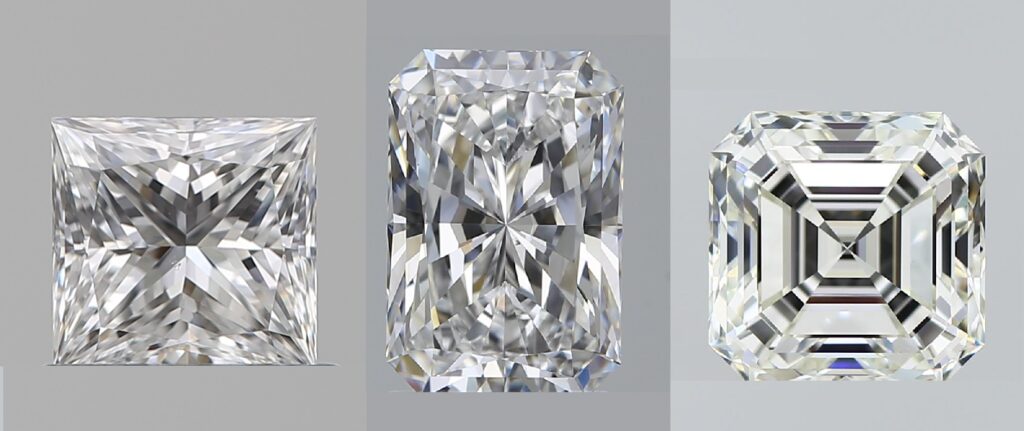
Princess vs Radiant vs Asscher Diamonds
Cushion cut diamonds are square or rectangular diamonds with soft, rounded corners – like a pillow! Cushions were the first “brilliant” diamond shape to be developed, straight out of the mines. This traditional faceting is still sought after today. In addition, newer faceting patterns have been developed which show a “crushed ice” type of brilliance. As a result, all Cushions are different.
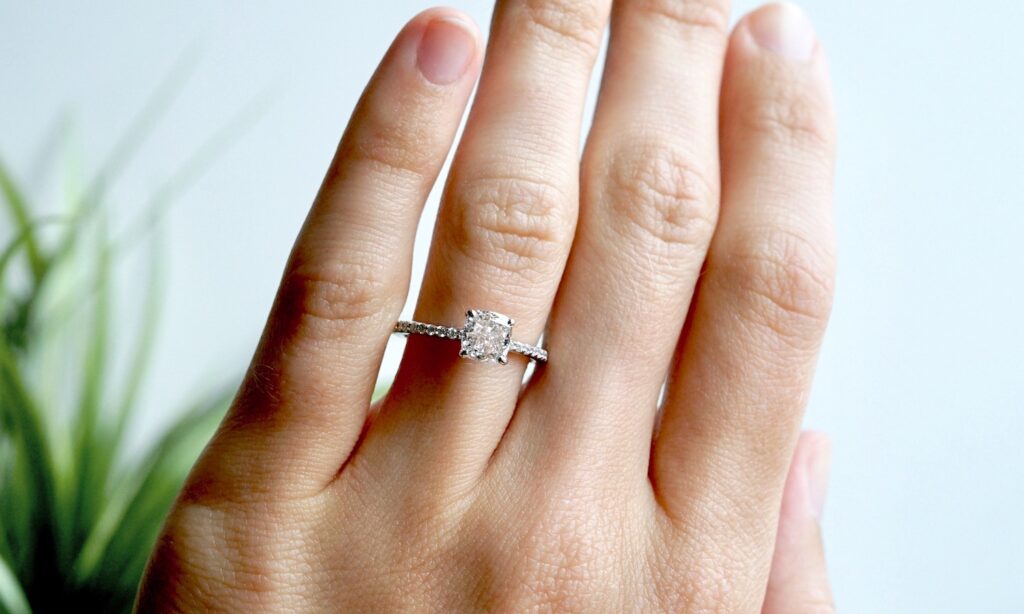
Diana Engagement Ring with 6.1mm Cushion Diamond
Because of its vintage history, many couples that choose Cushions also love other antique things. Do Amore’s gemologist, Corinne, has a Cushion and loves all things vintage. As it is a brilliant-cut gem with soft lines, Cushions also appeal to couples seeking a “different” look while maintaining a traditional vibe. Finally, a Cushion diamond shape’s big flashy sparkle often also attracts playful couples, looking for something more whimsical.
Cushion diamond shapes are notorious for being cut pretty deeply. Not all, but many. So, if size is your number one priority, a Cushion is maybe not the best shape for you as you’ll have fewer options. Couples that want a big, elongated look should also consider an Oval.
Because of the multiple ways Cushion cuts are faceted, couples choosing Cushions should first decide whether they like vintage big flash, or crushed ice brilliance. Also, because Cushions are often cut deeply, couples should make sure to maximize their measurements within carat range. In other words, make sure your diamond isn’t carrying all its weight at the bottom where you can’t see it! Check out our Cushion cut diamond buying guide for more info on how to select the best Cushion.
Couples that love Cushion diamond shapes should also check out Radiants and Ovals. Both Ovals and Radiants are brilliant cut, like Cushions, and have a unique look. Whereas Ovals are softer shapes than Cushions, Radiants are more modern. Both give a unique, elongated appearance.

Elongated Cushion vs Oval vs Radiant Diamonds
Oval cut diamonds are cut much like Rounds, with an elongated shape. First designed by Ideal Diamond creator Lazare Kaplan in 1957, Ovals are “brilliant” cut. This means they produce a bunch of sparkle! Because of their long, slender shape, Ovals often look larger than Rounds of the same carat weight.
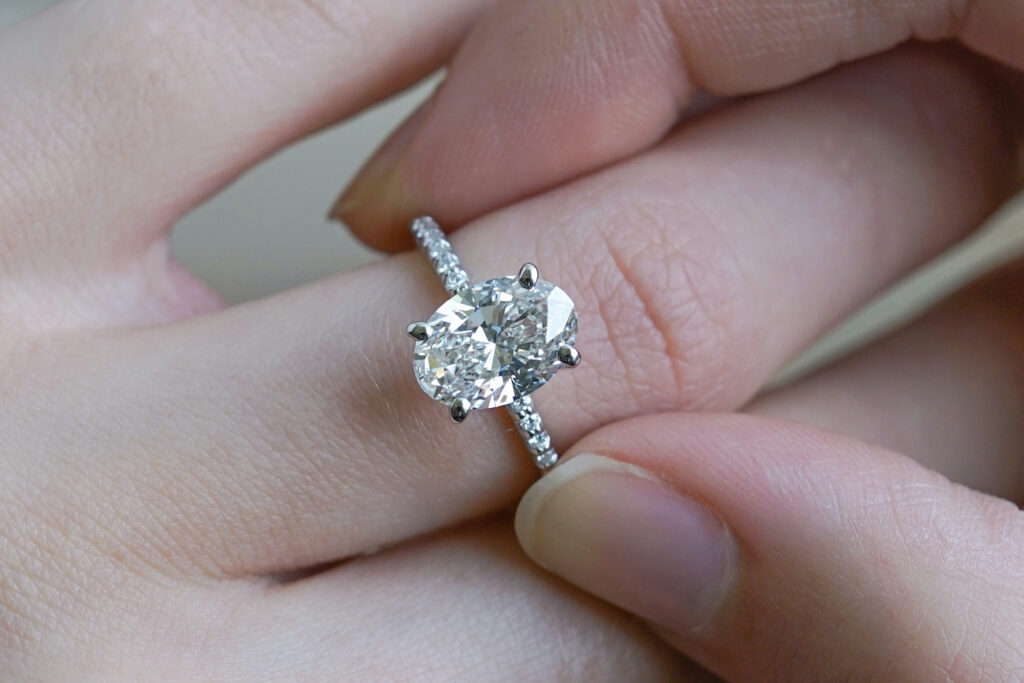
Diana Engagement ring with 10x7mm Oval Diamond
Because of its familiar shape and traditional lines, Oval diamond shapes are a lovely choice for couples who don’t want something super traditional, but still want something classic. Do Amore’s founder, Krish, proposed with an Oval diamond!
Oval shaped diamonds are a classic, traditional choice. In other words, couples looking for a more edgy, modern look will not find it in an Oval. Instead, couples should seek out hard-edged diamond shapes like Princess, Radiant, and Emerald.
Oval cuts can show a dark “bowtie” shadow in the center due to its long shape, so couples should look for gems that do not have bowties. Also, Ovals can show more color in their top and bottom than other shapes, so look out for consistent color as well! Finally, look for a pleasing outline. The Oval shape is why you love the stone – make it pretty! Click here to learn about length-to-width ratio and how to choose a pleasing Oval shape in our Oval diamond buying guide.
Couples that love Ovals should also check out Marquise and elongated Cushions. Just like Ovals, Marquise stones are graceful, slender shapes that elongate the finger. And, Marquise cut diamonds look even larger than Ovals of the same carat weight! Elongated Cushions are rectangular gems with soft corners. So, this diamond shape will also appeal to couples looking for a slim outline. Cushions and Marquise sparkle a bit differently than Ovals do, so comparing these gems side-by-side is a great way to confirm you really want an Oval!
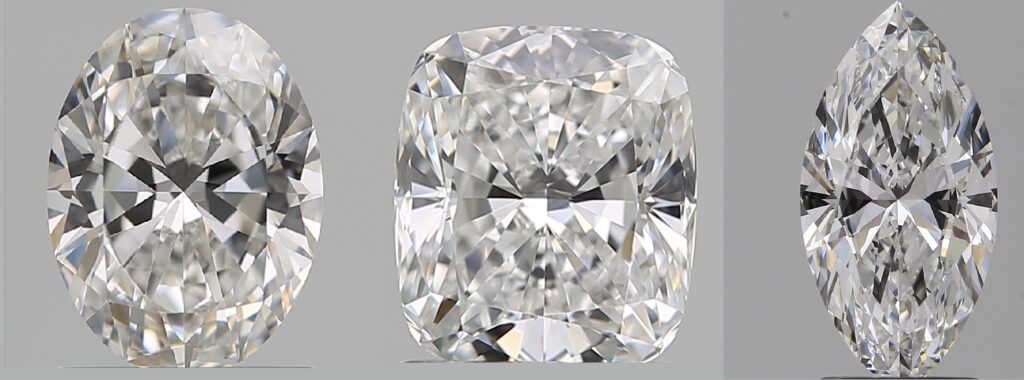
Oval vs Elongated Cushion vs Marquise Diamonds
Emerald cut diamonds are long, rectangular diamonds with facets that create a “hall of mirrors” effect. They are the first of two “step” cut diamonds we will discuss. Step cuts are faceted much differently than “brilliant” cut diamonds. Instead of the traditional “sparkle” you see in most diamond shapes, Emerald cuts glimmer. They were designed to showcase color and high clarity. In other words, their sparkle does not mask inclusions or slight color tint like other diamonds. For this reason, they are a popular choice for high-end engagement rings.
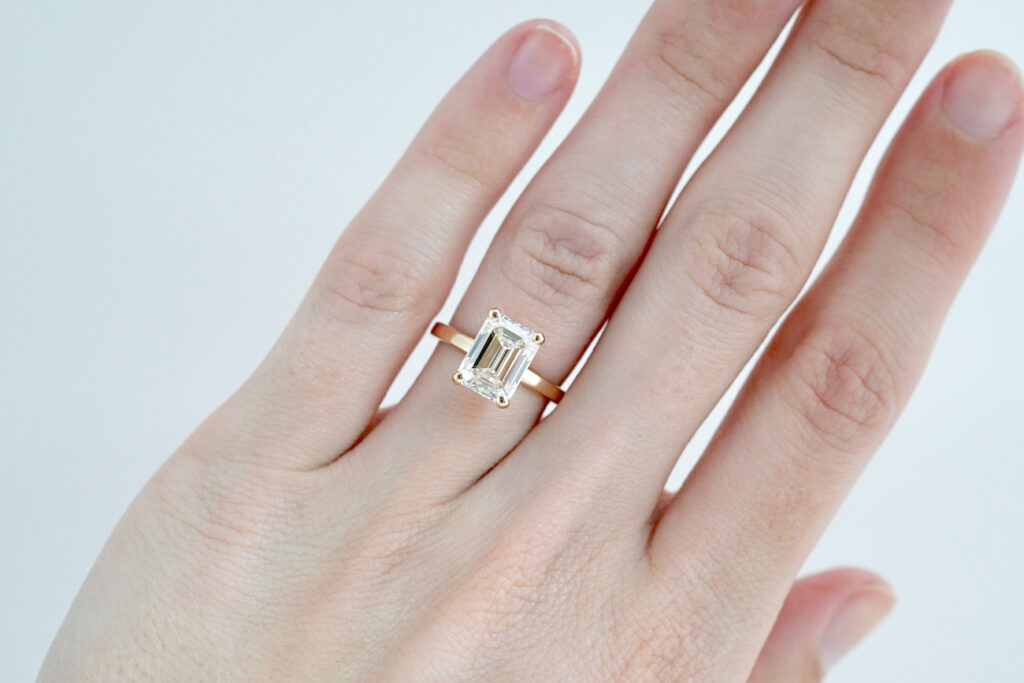
Asha Engagement Ring with 9.5x7mm Emerald Diamond
With its soft mirror-like glimmer, Emerald cuts are a great choice for couples wanting something more subtle. An Emerald cut’s elegant, old-world glamour is also an excellent choice for those who want their engagement ring to exude high-end quality. Because of its color and clarity needs, the best Emerald couples are those that don’t mind spending a bit more on their center stone.
The big takeaway about Emeralds is that they do not “sparkle.” So, if maximum sparkle is your goal, an Emerald cut is not for you. Couples looking for a rectangular, sparkly stone should check out Radiants. Also, because of its necessary high color and clarity, couples looking for bang for their buck will not find it in an Emerald.
Emerald cuts can show a dark “black box” in the center due to its mirror faceting. So, when rocking an Emerald cut back and forth, look for vertical dark and light play, without a boxy horizontal dark area. Because Emeralds show inclusions so easily, always remember to pay close attention to clarity. Most Emerald cuts need to be at least VS1 (and often VVS2+) to ensure eye clean clarity. Click here for more tips and tricks on choosing a great Emerald-cut!
Couples that love the rectangular look of an Emerald, but want more glitz, should check out the Radiant cut. Radiants are “brilliant” diamonds with the shape of an Emerald! For those that love the glamorous look of an Emerald, but also need a better-priced stone, check out an elongated Cushion. Elongated cushions, especially those that are more traditionally faceted, give a soft glimmer similar to an Emerald. But, because Cushions are brilliant-cut, couples can often get away with lower color and clarity, making them a more affordable choice than Emerald. Finally, those that love Emeralds will also love the lesser-known Asscher cut. Asschers are square Emerald cuts!

Emerald vs Radiant vs Elongated Cushion vs Asscher
Radiant cut diamonds are long, rectangular diamonds with bright, sparkly facets. First faceted in the 1970s, Radiant cuts are the well-kept secret of rectangular diamonds. Not often shown in brick and mortar jewelers, Radiants have been chosen and worn by celebrities for decades. There are several faceting patterns available in Radiants. However, all include wide, clipped corners, like an Emerald cut.
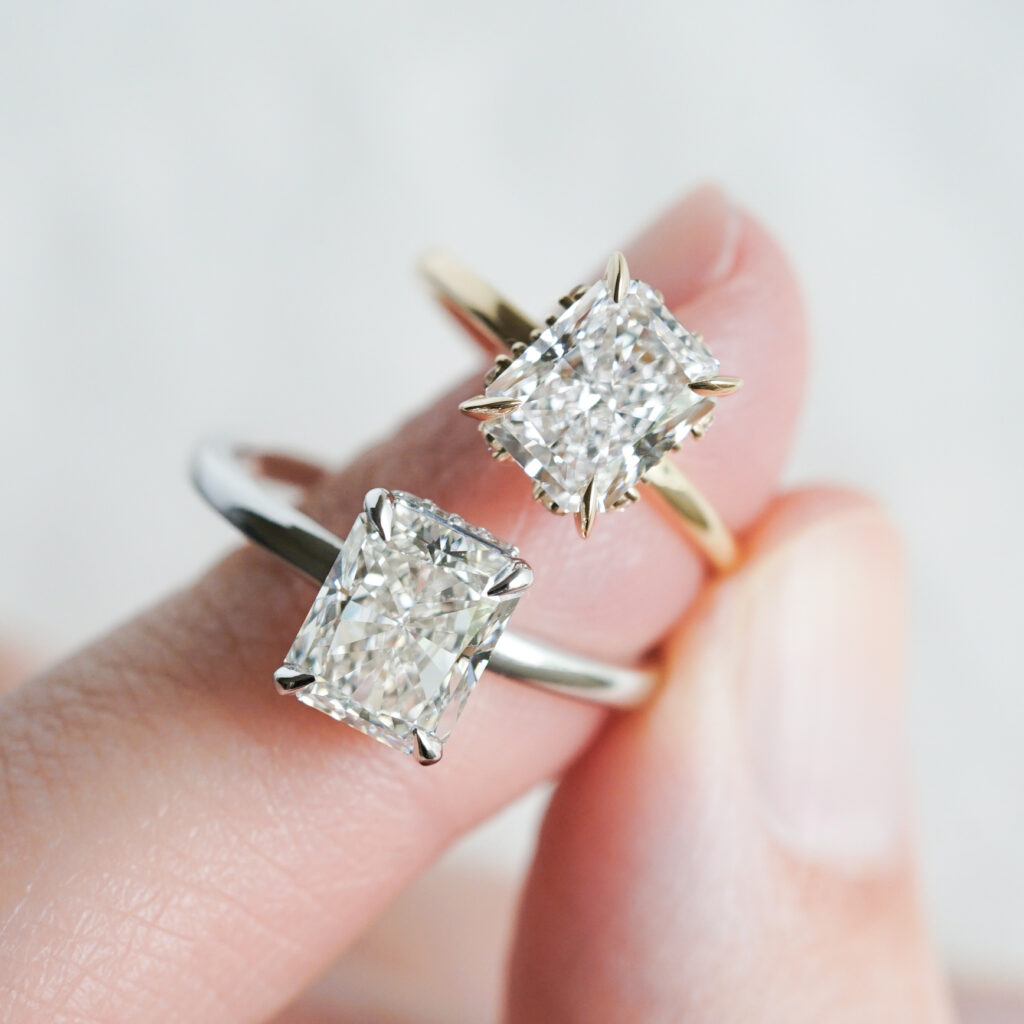
7.5x6mm Custom Radiant and 8x6mm Radiant in Jolie Ring
Radiants are a great pick for couples looking for something a little edgier than a traditional round, and who also want their stone to have great sparkle and established “cred.” Because Radiants have a history as a high-end choice, couples can feel confident choosing a Radiant. Because of its rarity, Radiants are a great choice for those looking for something unique. Finally, Radiants are a great rectangular choice because they don’t need super high color and clarity to look gorgeous.
A Radiant cut’s shape is quite edgy. It has hard lines and clipped corners. So, couples looking for a soft look will not find it in a Radiant. Also, because of its rarity, many people have never heard of Radiant cuts. As a result, couples looking for immediate recognition won’t get it in Radiant, and may wish to look at Princess cuts.
Radiant faceting can either show a more traditional facet pattern, or a “crushed ice” type of look. So, when looking for a Radiant, decide which one of these looks you’re going for first. Also, crushed ice Radiants can show color much easier than other shapes. So, pay attention to color in the top and bottom of the gem, where this “ice” is. You want consistent, white color. For more tips on choosing a great Radiant, check out our Radiant cut buying guide.
Couples that love the rectangular look of a Radiant should also check out elongated Princess cuts and Emerald cuts. Elongated Princess cut gems will give a similar look and will be less expensive than a comparable Radiant. To ensure you are getting the look you want, couples should also check out Emerald cuts, which have the same outline, with very different “sparkle.” Emerald cuts give more of a mirror-like sheen in comparison to Radiant cut’s sparkle. Finally, couples who love the “crushed ice” look of a Radiant should also consider an elongated Cushion, as certain Cushions also show this effect.

Traditional Radiant vs Emerald vs Elongated Princess vs Crushed-Ice Radiant
Pear-shaped diamonds look like a raindrop (or a hot air balloon!) They can be plump, skinny, or traditionally proportioned, depending upon the shape of the rough and the preference of the cutter. They can be worn with the point up, or down, based upon the wearer’s preference. The Pear shape was first designed in the 1400s! So, it has quite a bit of history to its name. Due to its brilliant faceting, Pear shapes give great sparkle.

8x5mm Pear Diamond in Elle ring
Pear shapes are unique in that they are asymmetrical. Whereas the top is an edgy point, the bottom is a graceful curve. So, those looking for a unique or artsy look will love it! This gives the wearer an option to change up the ring’s look simply by turning it upside down. They can also be set sideways or on a diagonal for a truly artistic expression.
Pears are lovely and unique. However, because of their asymmetry, Pears are not very traditional. As a result, this uniqueness makes them not the right choice for everyone. So, if you are looking for a classic, traditional engagement ring, a Pear shape may not be the right fit for you. Also, if part of your diamond shape decision is the stone’s “investment quality,” you may be better off with a more traditional shape like Round, Cushion, or Radiant.
Pear cuts can be slender, traditionally proportioned, or more chubby. I personally love a nice plump Pear. The most important thing is to make sure the shape is graceful. So, the curves should be soft, without pointy areas. And the point should be pointy – else you’ll have an egg! Finally, as color can gather at the tip of a Pear, couples should always look for even coloration. For more tips on how to choose a pretty Pear, check out our Pear-shaped buying guide.
Couples that love Pear shapes may also love a Heart shape. Similar in its asymmetry and unique nature, Heart cut diamonds are a romantic comparison shape. Couples looking at Pears should also compare them to Oval shaped diamonds. Ovals are long, elegant shapes like Pears, but with even more brilliance.
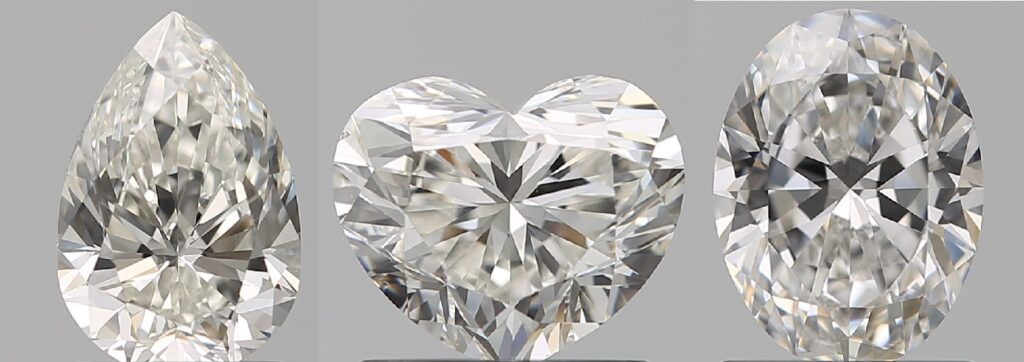
Pear vs Heart vs Oval Diamonds
Heart-shaped diamonds are just what you imagine, a diamond shaped like a Heart! They are brilliant-cut stones, which means they really sparkle. Hearts are the most romantic diamond shape, and also one of the rarest. Like Pears, they can be plump, skinny, or traditionally proportioned. Heart-shaped diamonds have been around since the 1500s and have a royal history.

Heart Shaped Diamond in Custom Ring
Heart shaped diamonds are whimsical and unique. They are best suited to romantics that love everything about love. Couples that I know who chose Hearts love rom-coms, all things Disney, and fairy tales!
Some couples love Hearts, and others greatly dislike them. This shape is very personal. So, if you are looking for something that has universal appeal, a Heart shaped diamond is not likely your best bet. This also means that if “investment quality” is a major concern in your ring shopping, you should instead consider a Round, Cushion, or Radiant.
Couples choosing a Heart diamond shape are doing so for its great shape – so that great shape is top priority! Soft “lobes” (the curves of the Heart) and a pointy tip are very important. Hearts can be slender, traditionally proportioned, or more chubby. I tend to advise against slender Hearts, as I don’t think they are as attractive. Finally, as color can gather at the point of the Heart, couples should always look for even coloration. For more tips on how to choose a lovely Heart, check out our Heart-shaped buying guide.
Couples that love Hearts are unlikely to want any other shape. However, for argument’s sake, I tend to suggest that people compare them, just in case! Good shapes to compare with Hearts are Pears and Marquise. Plump Pears have a similar appeal to Hearts, as they are asymmetrical and unique. I also love to show a nice fat Marquise. Plump Marquise have a whimsical appeal too, much like a playing card diamond. And Marquise will look larger!

Heart vs Plump Pear vs Plump Marquise Diamonds
Marquise cut diamonds are almond-shaped stones with points on the top and bottom. They are said to be shaped like a kiss! Designed in the 1700s, Marquise are brilliant-cut gems that look larger than any other diamond shape. Greatly popular in the 1970s and 1980s, Marquise are regaining popularity today thanks to their elegant length and large sizes. Like Pears, Marquise can be slender, traditionally-proportioned, or plump. New designers have been setting them horizontally, whereas traditionally, they are worn vertically to elongate the finger.
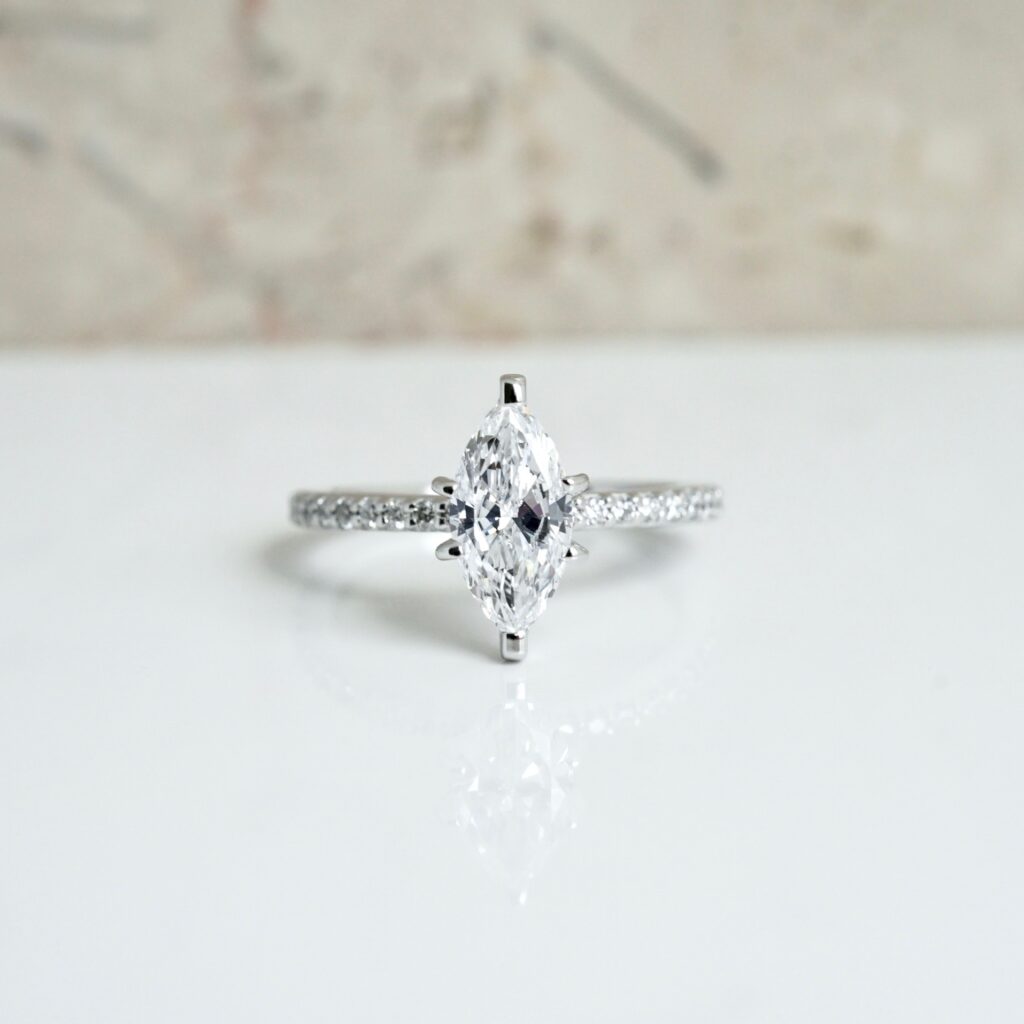
10x5mm Marquise Diamond in Diana Ring
Marquise are a rare and unexpected choice today. Because of the Marquise craze 40 years ago, some couples reject Marquise as a modern option. So, couples that like pushing boundaries may love the idea of shattering expectations with a great, modern Marquise ring. Also, a great reason to choose a Marquise is its amazing ability to look significantly larger than any other shape. So, those looking for a statement piece? They should check out a Marquise.
The Marquise’s popularity in 1970-1980 biases some people against them. Perhaps their mother had a Marquise, and they want something different. So, couples that have a pre-set notion that they dislike the shape will likely not be talked out of it. But I’ll try. Consider that Catherine Zeta-Jones’, Ashlee Simpson’s, and Portia de Rossi’s engagement rings are all beautiful Marquise!
Couples choosing a Marquise diamond shape typically do so for its elegant shape and size. So, choosing a stone with a pleasing outline is a big deal. Tips include making sure the curves of your stone are soft, not awkwardly flat or boxy, as well as that your points are actually pointy. In addition, Marquise can carry some extra color in their points, so always look for even color. For more tips on Marquises, check out our Marquise cut buying guide.
Couples that love Marquise are likely to also enjoy the appeal of Ovals and Pears. The rounded bottom and pointed top of a Pear is reminiscent of the Marquise’s outline, but a bit edgier. An Oval, on the other hand, gives a Marquise’s elegance but offers more brilliance.

Marquise vs Pear vs Oval Diamonds
Asscher cut diamonds are square stones with clipped corners and rectangular facets that create a “hall of mirrors” effect. Born from Emerald cuts, Asschers are “step” cut diamonds, which glimmer instead of “sparkle.” Asscher cuts flash between light and dark when you rock them side to side. Like their sister cut, Emerald, Asschers show off high color and clarity. So, their faceting does not hide inclusions or color tint. Instead, they magnify them. For this reason, couples that like high-end things often love Asscher cut stones.

Asscher cut diamond ring
With its hall of mirrors effect, couples love Asschers for their simple elegance and Art Deco appeal. As they do not sparkle like other gems, they are a good choice for low key couples, and also couples who want to show relaxed status. Because Asschers require high-end color and clarity, the best Asscher couples are those that don’t mind spending more on their center stone.
Again, Asscher cut diamonds shimmer, they do not sparkle like other diamonds. So, if max sparkle is your goal, an Asscher is not your cut. Couples looking for a square, sparkly stone should check out Radiants and Princesses. Because of its high color and clarity needs, couples looking for a great bargain will likely not find it in Asscher.
Asscher cuts can show a dark “black box” in the center, due to its mirror-like faceting. So, when viewing an Asscher, look for well-proportioned glimmer without a distracting black box. Because Asschers show inclusions so easily, another thing to pay close attention to is clarity. Most Asscher cuts need to be at least VS1 (and often VVS2+) to ensure eye clean clarity. Click here for more tips and tricks on choosing a great Asscher cut!
Couples that love the square look of an Asscher, but want more glitz, should check out the Princess cut. Princess cuts are “brilliant” diamonds with a square shape! For those that love the old world glamour of an Asscher, but need a better value, Cushion may be the ticket. Vintage and shimmery, square Cushions are often a better price than Asschers. Finally, those that love Asschers will also love their sister cut, the Emerald. In fact, you may find a better price in a squarish Emerald cut, than a perfectly square Asscher!

Asscher vs Princess vs Cushion Diamonds
Sure can! I’d love to talk with you about diamond shapes, comparison shapes, and how to pick the best shape for your lifestyle and finger! Email me or send us a note here with pictures, ideas, or questions and I’ll help you choose the perfect shape for you!
Verifiably Ethical & Sustainable
Guaranteed 1:1 Impact
Personalized 1:1 Customer Service
handcrafted & american-made
you before us, always
Verifiably Ethical & Sustainable
Guaranteed 1:1 Impact
Personalized 1:1 Customer Service
handcrafted & american-made
you before us, always
Thoughtfully crafted, made to last, and designed for life's most meaningful moments. LEARN MORE
Diamonds, Gemstones, & Metals
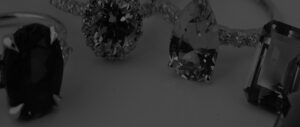
Every piece of Do Amore jewelry begins by not hurting the world. All our natural diamonds are either ethically sourced in Canada, recycled to eliminate additional demand, or accompanied by a blockchain ledger showing every hand your diamond passed through, proving your stone is truly conflict-free.
We also offer sustainable lab-created stones and guarantee all precious metals are recycled to eliminate the environmental impact of mining. Since March 2022, we carry absolutely no Russian diamonds and continue to urge the industry to follow suit.
Clean Water
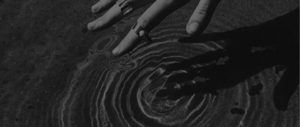
We desire to deepen the well of love in the world. We guarantee that every single purchase—whether engagement ring, wedding band, or piece of jewelry—directly impacts one person’s life by giving them access to clean water.
We do this by directly matching jewelry purchases to people in communities to ensure our funding has a one-to-one impact. We also show you the exact GPS coordinates and a photo of the water well your ring or piece of jewelry helped fund.
Customer Service

As a small, 100% founder- and employee-owned team, one-to-one encounters are at the heart of our values. Whichever way you want support throughout your engagement ring or jewelry purchase process, our team is here to accommodate you.
From high-touch to hands-off, video calls to text messages, you have our dedicated, responsive team on your side from the moment you start your search, to the day your well is built, to the time we meet again.
Engagement Rings, Bands, & Jewelry
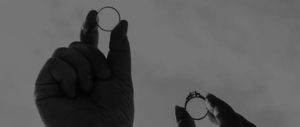
Every Do Amore design, whether one of our own or unique to you, is beautifully handcrafted in America and made specifically for you. Each ring is made to order, every time.
From classic to custom, you have the option to select from dozens of gorgeous settings or work with our design team to create something entirely bespoke. Plus, you are always covered for free inspections, polishing, cleaning, stone tightening, rhodium-plating, and resizing for life.
Our Promise

We care about what matters most to you, not what’s easiest for us. If it’s a minor change to a setting or arriving at a completely custom design, we work to ensure you get precisely what you love.
From statement-making to understated, we have options at any price point. Plus, you always have our team on your side searching to bring you every stone within your specifications. We also offer 60-day returns and a limited lifetime warranty to cover you in the rare event of a manufacturing defect.